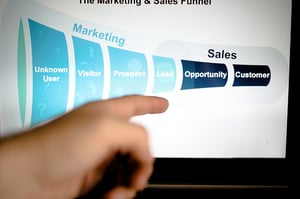All Leads Are NOT Created Equally; Do You Know The Value Of Your Sales Pipeline?

We continue to hear reports from prospective clients that they’re still not hitting their revenue goals in a consistent, scalable and predictable way.
Could it be that while we were busy smashing the funnel, we should have also been looking at smashing the traditional pipeline view of company sales opportunities?
Let’s look at the details associated with pipeline setup, management and measurement, and how to better use data to predict the value of your pipeline and then how that value translates into sales revenue.
Quality Instead Of Quantity
Traditional sales pipelines show you how much opportunity you have at each stage of your process. Paired with sales rep activity, they allow you to figure out where the gaps are, both in lead generation and sales process execution. Generally, businesses look at the sales pipeline to figure out their new business forecast and to measure the effectiveness of their sales and marketing strategy.
Most look at number of opportunities and number of closed-won deals. That’s generally the only stats they pay attention to. However, you should really be watching the volume at each stage of your process, as well as how long it takes for deals to move from one stage to the next and the conversion rates at each stage.
The way most sales leaders look at their pipeline means they’re emphasizing quantity over quality. Traditional sales mentality is that it’s a numbers game – if you have enough “at bats,” you’ll be able to get a hit.
While this does hold true to a certain extent, buyer behavior has changed so much that you can’t assume you’ll close business by just having a lot of activity.
Nowadays, buyer options are so vast that you need to ensure each “at bat” is handled like it’s the bottom of the ninth inning and you’re down by one run. As a sales rep, you are doing yourself a disservice if you don’t closely analyze each and every opportunity to make sure your execution is top notch.
Traditional pipeline views also ignore the length of stay an opportunity has in your deal stages. Stagnation in a sales pipeline is a killer.
Time kills almost every deal. Think about the last time you had a great conversation and then the prospect when dark. Did they come back ready to go, or did they emerge with bad news? No need to answer that.
I would add that most businesses look at their sales pipeline in isolation when they should be looking at it in conjunction with their full revenue cycle, both marketing and sales metrics.
Volume ignores execution to an extent. Successful sales teams are full of reps that execute with top precision every time. That generally means fewer opportunities should still result in healthy results.
Volume also can mask bigger challenges, such as a gap in the value of what you’re actually selling.
Yes, it’s correct. Buyers have an immense number of options in almost every instance, so if they actually get to the point where they want to engage with your sales team, you should be focusing on giving them a flawless experience.
These days, buyers are also a lot savvier and have more resources at their fingertips. That means a quality experience is going to be a basis for a relationship that can make the difference when it comes down to finally making a buying decision.
Why Scoring Leads Is No Longer Optional
You can’t simply look at the number of leads by stage anymore. Today, you have to be focusing on quality leads that allow the sales team to have quality conversations and spend their time working with companies that have a high likelihood of closing.
Remember, the game is not about talking to as many people as possible, it’s about closing as many people as possible.
As for the type of leads you are looking to attract into your sales cycle, you absolutely want to pull in quality over quantity. Otherwise, you are going to have fatigue from your team dealing with unqualified opportunities. That can negatively impact everything from morale and sales rep retention to the bottom-line revenue of your organization.
Lead scoring is a great first step. Measure every interaction with your brand that you can and use it to quantify the quality of your leads. People who spend more time on your website or visit key pages (like your pricing page) might be a better-quality lead.
People who have visited your two biggest competitors or searched for key search terms might be a better-quality lead. This is called visitor intent, and we can now use this pre-conversion data to measure visitor intent and build that into your lead-scoring model.
People who have shared more details about their business or their buyer journey will be a better-quality lead. By scoring your leads, you can score your pipeline, too. The higher your pipeline score, the better your chances to hit your revenue goals.
Consider Pipeline Velocity
Pipeline velocity is defined as the speed by which leads move through your pipeline, whether won or lost. What’s interesting about the pipeline velocity metric is that you should care more about the changes in the number over time than you should about the actual number. In other words, pipeline velocity data is only relevant when compared to the velocity over time.
Tracking pipeline velocity is a lot like tracking regular velocity, which is to say you divide a change in position by the change in time. In the case of your pipeline, the equation is this: number of sales-qualified leads in your pipeline times the overall win rate percentage of your sales team times the average deal size (in dollars) divided by your current sales cycle in days.
Using this formula, your result will be the estimated amount of revenue you have coming through the pipeline every day. The higher that number, the better your pipeline velocity. To learn more about pipeline velocity and see some specific examples, check out this blog article.
Why Sales And Marketing Alignment Is Critical For A Healthy Pipeline
Sales doesn’t operate in a vacuum or on its own anymore. Your prospects are looking for one seamless experience that allows them to flow through all stages of their buyer journey, which typically starts with marketing experiences and then converts into sales experiences.
This means aligning your marketing and sales team is no longer optional; it’s a requirement.
Marketing is not responsible for generating leads; marketing is responsible for generating highly qualified leads that have a high likelihood of closing quickly.
Marketing can help sales create the nurturing required to take wonderful care of those highly qualified leads. Sales needs to report back to marketing about which assets are providing that experience and which ones might be detracting.
It’s one experience with one company, and it has to be flawless. This is critical if you’re going to be looking for fewer leads but higher quality leads. Each lead will be more valuable and need more nurturing to close.
This means sales is going to have to ask the right questions at the right time in the sales process and not hesitate to ask the hard questions early. Marketing will only be able to do so much when it comes to qualification and quality of the lead. Sales will have to do a lot of qualification, too.
When we work with clients to create these questions for sales, most of them are designed to get very specific answers.
- How does this project rank in terms of priority for you and your company? If it’s not the top priority, we don’t proceed.
- What is your budget for this project? You don’t know? What would you expect to spend for work like this? Over what time period? If their answers are not aligned with the investment we require, we don’t proceed.
- Who is going to make the final decision? You are? Will you be signing our agreement? No? Then who will sign that document? If we can’t get an audience with the actual decision-maker, we may not proceed.
These questions are used to keep the pipeline data accurate and representative of quality leads that have a high likelihood of closing, not just names in the CRM that sales is saying might close one day if everything goes well. I hope you see the difference.
How The Buyer Journey Is Impacting Pipelines
With more complexity in the buyer journey, understanding the value of your pipeline and managing the pipeline proactively is also going to be harder to execute.
A study from HubSpot showed that of all companies with fewer than 50 opportunities in their pipeline, a whopping 72% did not reach their goals for the month. From there, the failure rate dropped drastically — at 51 to 100 prospects, only 15% of the surveyed companies did not meet their monthly revenue objective.
This illustrates how critical it is to attract, connect, engage and move highly qualified prospects through your sales process expeditiously and continue to add new highly qualified prospects in a mechanized way. What you’re looking for is a revenue machine that runs in the background day in and day out.
To install that in your company, you’ll need to get intimate with each prospect’s buyer journey. You’ll need the inbound and outbound marketing strategy and tactics to attract enough potential prospects.
You’ll also need the nurturing content and rhythms to get prospects engaged with your company. Finally, you’ll need a remarkable sales process to help them move from prospect to opportunity and then new customer.
If you think this sounds hard, it is. But with the right experience, strategy, tools and analytics, you can have the revenue generation machine your company needs to grow. Ask us; we’ll talk you through it and then show you how we could build this for you.
